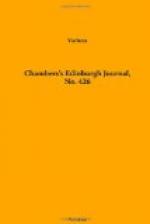Let us take a look at his personal appearance. Visionaries are usually slovens. They despise fashions, and imagine that dirtiness is an attribute of genius. To do the honourable member for Artois justice, he was above this affectation. Small and neat in person, he always appeared in public tastefully dressed, according to the fashion of the period—hair well combed back, frizzled, and powdered; copious frills at the breast and wrists; a stainless white waistcoat; light-blue coat, with metal buttons; the sash of a representative tied round his waist; light-coloured breeches, white stockings, and shoes with silver buckles. Such was his ordinary costume; and if we stick a rose in his button-hole, or place a nosegay in his hand, we shall have a tolerable idea of his whole equipment. It is said he sometimes appeared in top-boots, which is not improbable; for this kind of boot had become fashionable among the republicans, from a notion that as top-boots were worn by gentlemen in England, they were allied to constitutional government. Robespierre’s features were sharp, and enlivened by bright and deeply-sunk blue eyes. There was usually a gravity and intense thoughtfulness in his countenance, which conveyed an idea of his being thoroughly in earnest. Yet, his address was not unpleasing. Unlike modern French politicians, his face was always smooth, with no vestige of beard or whiskers. Altogether, therefore, he may be said to have been a well-dressed, gentlemanly man, animated with proper self-respect, and having no wish to court vulgar applause by neglecting the decencies of polite society.
Before entering on his public career in Paris, Robespierre had probably formed his plans, in which, at least to outward appearance, there was an entire negation of self. A stern incorruptibility seemed the basis of his character; and it is quite true that no offers from the court, no overtures from associates, had power to tempt him. There was only one way by which he could sustain a high-souled independence, and that was the course adopted in like circumstances by Andrew Marvel—simple wants, rigorous economy, a disregard of fine company, an avoidance




